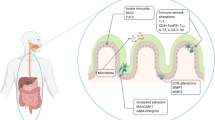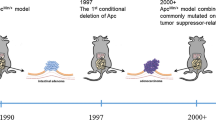Abstract
Background
As a potential tumor suppressor gene, Claudin-7 (Cldn7), which is a component of tight junctions, may play an important role in colorectal cancer occurrence and development.
Aims
To generate a knockout mouse model of inducible conditional Cldn7 in the intestine and analyze the phenotype of the mice after induction with tamoxifen.
Methods
We constructed Cldn7-flox transgenic mice and crossed them with Villin-CreERT2 mice. The Cldn7 inducible conditional knockout mice appeared normal and were well developed at birth. We induced Cldn7 gene deletion by injecting different dosages of tamoxifen into the mice and then conducted a further phenotypic analysis.
Results
After induction for 5 days in succession at a dose of 200 µl tamoxifen in sunflower oil at 10 mg/ml per mouse every time, the mice appeared dehydrated, had a lower temperature, and displayed inactivity or death. The results of hematoxylin–eosin staining showed that the intestines of the Cldn7 inducible conditional knockout mice had severe intestinal defects that included epithelial cell sloughing, necrosis, inflammation and hyperplasia. Owing to the death of ICKO mice, we adjusted the dose of tamoxifen to a dose of 100 µl in sunflower oil at 10 mg/ml per mouse (aged more than 8 weeks old) every 4 days. And we could induce atypical hyperplasia and adenoma in the intestine. Immunofluorescent staining indicated that the intestinal epithelial structure was destroyed. Electron microscopy experimental analysis indicated that the intercellular gap along the basolateral membrane of Cldn7 inducible conditional knockout mice in the intestine was increased and that contact between the cells and matrix was loosened.
Conclusions
We generated a model of intestinal Cldn7 inducible conditional knockout mice. Intestinal Cldn7 deletion induced by tamoxifen initiated inflammation and hyperplasia in mice.









Similar content being viewed by others
Abbreviations
- ICKO:
-
Inducible conditional knockout
- HE:
-
Hematoxylin–eosin
- TJs:
-
Tight junctions
- SPF:
-
Specific pathogen free
- PCR:
-
Polymerase chain reaction
- CKO:
-
Conventional knockout
References
Schneeberger EE, Lynch RD. The tight junction: a multifunctional complex. Am J Physiol Cell Physiol. 2004;286:C1213–C1228.
Koller BH, Hagemann LJ, Doetschman T, et al. Germ-line transmission of a planned alteration made in a hypoxanthine phosphoribosyltransferase gene by homologous recombination in embryonic stem cells. Proc Natl Acad Sci. 1989;86:8927–8931.
Tsujiwaki M, Murata M, Takasawa A, et al. Aberrant expression of claudin-4 and -7 in hepatocytes in the cirrhotic human liver. Med Mol Morphol. 2015;48:33–43.
Ding L, Lu Z, Foreman O, et al. Inflammation and disruption of the mucosal architecture in Cldn7–deficient mice. Gastroenterology. 2012;142:305–315.
Tanaka H, Takechi M, Kiyonari H, Shioi G, Tamura A, Tsukita S. Intestinal deletion of Cldn7 enhances paracellular organic solute flux and initiates colonic inflammation in mice. Gut. 2015;64:1529–1538.
EI Marjou F, Janssen K-P, Hung-Junn Chang B, et al. Tissue-specific and inducible Cre-mediated recombination in the gut epithelium. Genesis. 2004;39:186–193.
Liu P, Jenkins NA, Copeland NG. A highly efficient recombineering-based method for generating conditional knockout mutations. Genome Res. 2003;13:476–484.
Chan W, Costantino N, Li R, et al. A recombineering based approach for high-throughput conditional knockout targeting vector construction. Nucleic Acids Res. 2007;35:e64.
Barker N, van Es JH, Kuipers J, et al. Identification of stem cells in small intestine and colon by marker gene Lgr5. Nature. 2007;449:1003–1008.
Zhang L, Liu G, Zhang L. The research progress of gene targeting technology. Biotechnol Bull. 2010;9:51–55.
Gonzalez-Mariscal L, Namorado Mdel C, Martin D, Sierra G, Reyes JL. The tight junction proteins Cldn7 and -8 display a different subcellular localization at Henle’s loops and collecting ducts of rabbit kidney. Nephrol Dial Transplant. 2006;21:2391–2398.
Alexandre MD, Lu Q, Chen YH. Overexpression of Cldn7 decreases the paracellular CI-conductance and increases the paracellular Na+ conductance in LLC-PK1 cells. J Cell Sci. 2005;118:2683–2693.
Mendoza-Rodríguez CA, González-Mariscal L, Cerbón M. Changes in the distribution of ZO-1, occludin, and claudins in the rat uterine epithelium during the estrous cycle. Cell Tissue Res. 2005;319:315–330.
Bhat AA, Pope JL, Smith JJ, et al. Cldn7 expression induces mesenchymal to epithelial transformation (met) to inhibit colon tumorigenesis. Oncogene. 2015;34:4570–4580.
Philip R, Heiler S, Mu W, Büchler MW, Zöller M, Thuma F. Cldn7 promotes the epithelial–mesenchymal transition in human colorectal cancer. Oncotarget. 2015;6:2046–2063.
Nishihama R, Ishida S, Urawa H, Kamei Y, Kohchi T. Conditional gene expression/deletion systems for marchantia polymorpha using its own heat-shock promoter and cre/Loxp-mediated site-specific recombination. Plant Cell Physiol. 2015;57:271–280.
Okuyama T, Isoe Y, Hoki M, et al. Controlled Cre/Loxp site-specific recombination in the developing brain in medaka fish, Oryzias latipes. PLoS ONE. 2013;8:e66597.
Trinh KR, Morrison SL. Site-specific and directional gene replacement mediated by cre recombinase. J Immunol Methods. 2000;244:185–193.
Acknowledgments
We would like to thank the Nanjing Biomedical Research Institute of Nanjing University for technical support, including construction of the Cldn7-flox mice and breeding of Cldn7 ICKO mice. We are grateful to the French professor, Sylvie Robine, who provided Villin-CreERT2 mice for us. This work is supported by the National Natural Science Foundation of China (Nos. 81372585 and 81772557), Beijing Municipal Education Commission Science and Technology Program of the Project (No. KM201410025026), and Beijing Health System High Level Training Plan of Health Technical Personnel (2014-3-048). This work is also supported by National Institutes of Health Grant DK103166 to Yan-Hua Chen.
Author information
Authors and Affiliations
Contributions
W-JL, CX and KW are the co-authors of this paper; W-JL is the lead author. W-JL analyzed the data and drafted the manuscript; W-JL, CX and KW performed the experiments; LD and HG designed this research and modified the manuscript, and Y-HC provides guidance of the experimental design about the suitable dosage of tamoxifen; T-YL, X-NW, HY, and TX contributed to breeding mice and providing analytical tools; W-XL contributed to related reagents. All authors have read and approved the final version.
Corresponding authors
Ethics declarations
Conflict of interest
All authors declare that they have no conflict of interest.
Ethical statement
All applicable international, national and/or institutional guidelines for the care and use of animals were followed. All procedures performed in studies involving animals were in accordance with the ethical standards of the institution or practice at which the studies were conducted.
Additional information
Lei Ding is the lead author of the manuscript.
Rights and permissions
About this article
Cite this article
Li, WJ., Xu, C., Wang, K. et al. Severe Intestinal Inflammation in the Small Intestine of Mice Induced by Controllable Deletion of Claudin-7. Dig Dis Sci 63, 1200–1209 (2018). https://doi.org/10.1007/s10620-018-4973-z
Received:
Accepted:
Published:
Issue Date:
DOI: https://doi.org/10.1007/s10620-018-4973-z




